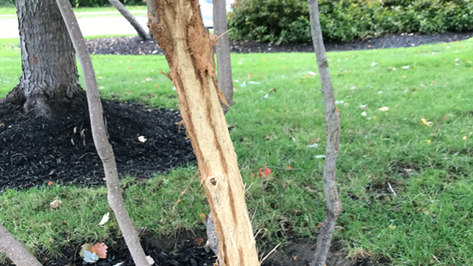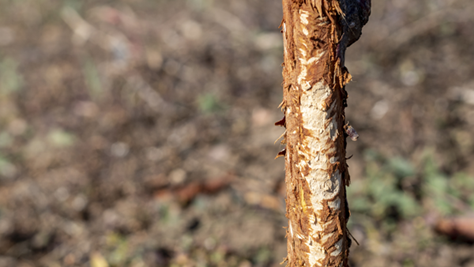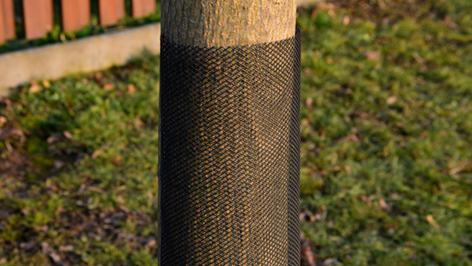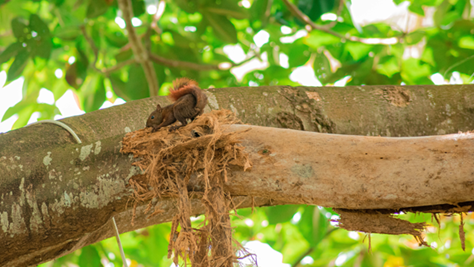Along with all the joys in your yard -- the warming sun’s rays, magnolia blossoms, cornflower blue skies and fabulous fall colors bursting from the leaves on your trees -- come the four-legged critters that can drive you crazy.
We’re talking about squirrels, rabbits and deer. Sure, not all of them may be present in your landscape, but even a couple may be eyeing your favorite trees and causing damage. Whether rabbits and squirrels are chewing off the outer bark of your trees or deer are rubbing their antlers against your trees, the wear and tear can add up.
Your trees are staples in your yard, and while you welcome wildlife, you’d hate to see them destroy these strong, sturdy plants in your yard that provide you with spring blooms, summer shade, and autumn splendor.
You can live in harmony with the wildlife that scurries through your landscape. Here is how to protect your trees from animals.
How to Protect Young Trees from Animals
You might be storing your gardening supplies in your garage or garden shed for the winter, but you have one more thing to do before you pack everything away for the next couple months. Now is the time to take some precautions to protect your young trees from animals.
Deer, rabbits and squirrels are active all year long, which means they can cause harm to your trees no matter what the season. This is why protecting your largest landscape investments is an important step in your landscape maintenance.
While you may remember to protect smaller plants like annuals and perennials from animals, you may overlook your trees. They stand tall and strong after all, so what could possibly take them down? Small trees are especially vulnerable to several types of animal damage.
Deer Damage to Trees

Tree damage starts with deer. Even when you shoo them away from your yard, they seem to always return. And in the late summer and early fall, it can feel like deer are everywhere.
The deer damage to young trees can include:
- Male deer rubbing their felted antlers against young trees to wear off the velvet or “buck rubbing.” This often impacts smaller trees, usually 1 to 4 inches in diameter. And trees with thinner bark like redbuds or birch can be highly susceptible. But all your trees are fair game. Most trees can recover from small bits of damage to their bark, though they may lose limbs located above a damaged spot. Others that are rubbed repeatedly and around the entire circumference can suffer from girdling, which can sometimes cause tree death.
- Deer can browse in your yard throughout the year, but this can become more noticeable in late fall and winter when their other food sources are less available. Hungry deer will snack on anything. One adult deer can eat up to 4 pounds of twigs daily. Browsing is usually apparent in random and ragged tree leaves and stems edges from the ground up to as high as 6 feet up the tree. Browsing can reduce tree growth and impact its stem production by creating multiple stems.
How to Repair Tree Bark Damage from Deer
During the breeding season in September through November, deer can go buck wild on your landscape trees, causing some serious damage by rubbing their antlers on trunks as they mark their territories.
Your younger trees that are 1 to 6 inches in diameter with smooth bark -- everything from maples to birch to lindens to magnolias -- are more likely to suffer damage. And damage can happen quickly: over a 24-hour period.
While this may just seem like nuzzling from afar, this aggressive rubbing can hit a tree’s vascular system just below the bark, which is the tree’s main way of transporting water and nutrients to roots and leaves. When rubbed around the trunk entirely, the damage can girdle the tree and result in death over the next 1 to 3 years.
If damage is located only on one side, the tree can survive.
To help repair deer damage to young trees, trim off loose, shredded bark or broken branches and let the wounds heal. A professional arborist can treat extensive tree damage correctly to help you save your tree.
How to Protect Trees from Deer Damage
If you’re noticing deer wandering through your neighborhood but haven’t seen any damage in your yard yet, you might want to be proactive and learn how to protect trees from deer damage.
Protect the trunks of your trees from the ground to about 6 feet up. Wrapping them with burlap may not be enough. A sturdy hardware wire mesh with ½-inch or smaller openings or plastic tree wraps work better.
Deer repellants can help deter browsing, but they won’t keep deer from rubbing against tree trunks.
Rabbit Damage to Trees

Sure, Peter Cottontail is cute … until he damages that tree you just planted.
When cottontail rabbits and jackrabbits chew stems, buds, small branches and bark off of trees approximately 18 to 20 inches off of the ground, they can leave bare wood all around the base of the tree. This is called girdling. Sap has trouble flowing past the chewed up area, which can cause the top part of the tree to gradually die.
In fact, rabbit damage to young trees can happen in winter (December through February) when your smaller trees are sticking up above the snow. In this case, damage can be higher up the tree depending on the snow height. Young trees are most susceptible to rabbit damage until their smooth, thin bark turns thick and rough with age.
Rabbits tend to damage crabapples, serviceberries, cotoneasters, viburnums, dogwoods, spireas and others. Rabbit damage to fruit trees like apples, plums and cherries is also fairly common during the winter.
How to Repair Tree Bark Damage from Rabbits

When rabbits eat the bark all the way around the tree, that girdling damage is something that can be near impossible to repair. Removing and replacing your tree might be your best bet, depending on the extent of the damage. Talking to a professional certified arborist can confirm your worries if you see severe rabbit damage.
Can you repair rabbit damage to fruit trees? If the damage is less than 25% of the circumference of the tree, the wound should heal itself. Remove any loose bark or wood from around the wound and leave it exposed to air. Don’t cover it with any wound dressings.
If rabbits have removed the bark more than halfway around the tree, you may notice a reduction in the tree’s vigor and it may begin losing branches. Proper care from your local arborist can help the tree slowly recover. It may take some time for your tree to bounce back, so be patient.
How to Protect Trees from Rabbits
The most effective way to protect your young trees from rabbit chewing is to put a fence around the tree trunks so they’re out of the reach of pesky rabbits.
Use chicken wire or hardware cloth to build your fence. Make sure the fence is at least 30 inches above the ground and 6 inches below ground, as well as 2 inches or more away from the tree trunk. This ensures hungry rabbits can’t crawl underground or reach the tree in any way.
Squirrel Damage to Trees

Squirrels may look pretty busy out there as they gather acorns and scurry about. But they can also cause some serious wounds on your favorite trees.
Squirrels feed on tree fruits, nuts, roots, buds and tender leaves. They also eat bark and small twigs and branches to try and keep their teeth shiny, sharp and strong. If they remove too much root bark, they can girdle and die. If too many roots die, the tree loses its ability to take up water and nutrients. When damage to trees by squirrels is excessive in the leaves and branches this can cause poor branching or prevent the tree from being able to photosynthesize and feed itself. This can slow growth or possibly kill your tree.
How to Repair Tree Bark Damage by Squirrels
If squirrels only ate the bark on one side of your tree’s branches (less than ¼ of the circumference), the branch will survive and the wound will eventually heal.
With more than ¼ eaten, though, the odds of survival decrease. There’s less hope if the branch is chewed all the way around.
Prune branches with a lot of damage and leave any with less damage. Don’t cover wounds because research has shown that this delays healing and can even encourage disease.
How to Protect Trees from Squirrel Damage
To protect your susceptible trees from squirrel damage, you can wrap some metal flashing at least 2 feet wide around the trunks of the trees up to about 5 feet.
Squirrels can jump vertically about 4 feet, so the 5 foot flashing height helps prevent them from gaining traction when jumping onto the tree. But if they are jumping from one tree to another from the top, the flashing may not help prevent damage to trees by squirrels.







